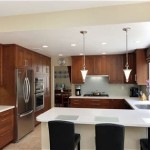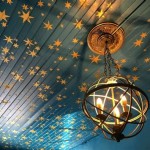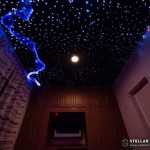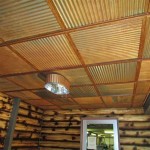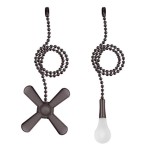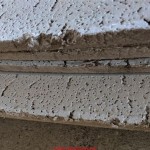False Ceiling LED Strip Light Design: An Illuminating Guide
False ceiling LED strip lighting has emerged as a prominent design element in modern interior spaces. Its versatility, energy efficiency, and aesthetic appeal have made it a popular choice for both residential and commercial applications. This article explores the various aspects of false ceiling LED strip light design, offering insights into its benefits, considerations, and practical implementation.
A false ceiling, also known as a suspended ceiling or dropped ceiling, is a secondary ceiling installed below the main structural ceiling. This creates a cavity that can house wiring, ductwork, and other utilities, while also providing a surface for lighting integration. LED strip lights, also called LED tape lights, are flexible circuits populated with light-emitting diodes (LEDs). Their thin profile and adhesive backing allow them to be easily concealed and installed within the false ceiling structure, producing a diffused and ambient light effect.
The integration of LED strip lights into false ceiling design offers a multitude of advantages. Beyond the purely aesthetic, it brings functional and practical improvements to the illuminated space. Understanding these benefits is crucial when considering incorporating this design element.
Enhanced Aesthetics and Ambiance
The primary appeal of false ceiling LED strip lighting lies in its ability to create a visually appealing ambiance. The concealed light source produces a soft, even glow that enhances the overall atmosphere of the room. This indirect lighting minimizes glare and shadows, contributing to a more comfortable and relaxing environment. LED strip lights are available in a wide range of colors, allowing for customization of the lighting scheme to match the desired mood and decor. Color-changing LED strips further enhance the dynamic capabilities, enabling users to adjust the lighting to suit different occasions or preferences. The flexibility of the strips allows them to be molded to various shapes and patterns within the false ceiling, facilitating unique and bespoke design features. This adaptability allows designers to create visually interesting features that can transform the space and add an element of sophistication and style.
Furthermore, the seamless integration of LED strip lights within the false ceiling creates a clean and uncluttered look, concealing the lighting fixtures and wires. This contributes to a minimalist aesthetic, which is highly sought after in contemporary interior design. The ability to control the intensity of the light allows for customized output, making it suitable for both task lighting and accent lighting. By strategically placing the LED strips, certain features of the room can be highlighted, creating focal points and adding dimension to the space.
The aesthetic impact of false ceiling LED strip lighting extends beyond visual appeal. The quality of light emitted by LEDs contributes to a more pleasant and healthier environment. Unlike traditional fluorescent lighting, LEDs do not flicker, reducing eye strain and fatigue. The absence of ultraviolet (UV) radiation also protects artwork and furniture from fading. The low heat emission of LEDs also reduces the load on air conditioning systems, leading to further energy savings.
Energy Efficiency and Cost Savings
Compared to traditional lighting technologies such as incandescent and fluorescent lamps, LED strip lights offer significant energy savings. LEDs consume significantly less power to produce the same amount of light, resulting in lower electricity bills. Their long lifespan further reduces maintenance costs, as replacement frequency is significantly reduced. The lifespan of LED strip lights can range from 30,000 to 50,000 hours, compared to a few thousand hours for incandescent lamps. This translates to fewer replacements and less disruption to the space.
The energy efficiency of LED strip lights also contributes to a reduced carbon footprint. By consuming less electricity, they help to reduce the demand for power generation, which often relies on fossil fuels. This makes LED strip lighting a more sustainable and environmentally friendly lighting option.
The initial cost of LED strip lights may be higher than traditional lighting options, but the long-term cost savings more than compensate for this difference. The reduced energy consumption and maintenance costs result in a lower total cost of ownership over the lifespan of the lighting system. Government incentives and rebates may also be available to further reduce the initial cost of LED lighting upgrades.
The ability to control the brightness of LED strip lights through dimming further enhances their energy efficiency. Dimming the lights reduces their power consumption, extending their lifespan and saving even more energy. This is particularly beneficial in areas where full brightness is not always required, such as bedrooms and living rooms.
Versatility and Functionality in Design Implementation
LED strip lights offer a high degree of versatility in terms of design and functionality. Their flexibility allows them to be easily installed in a variety of configurations, including straight lines, curves, and complex shapes. This makes them suitable for a wide range of applications, from simple accent lighting to elaborate architectural features. They can be easily cut to length and connected using connectors, enabling customization to fit specific spaces and design requirements.
The compact size of LED strip lights makes them ideal for installation in tight spaces, such as within the recesses of a false ceiling. This allows for a seamless integration of the lighting system, without compromising the aesthetics of the space. The adhesive backing of the strips simplifies installation, eliminating the need for complex mounting hardware. The low heat emission of LEDs also allows them to be installed close to other materials, without the risk of damage.
LED strip lights are available in a variety of color temperatures, ranging from warm white to cool white. This allows for customization of the lighting scheme to match the specific needs of the space. Warm white light is ideal for creating a cozy and inviting atmosphere, while cool white light is better suited for task lighting and areas where high visibility is required. Color-changing LED strips offer even greater flexibility, allowing users to select from a wide range of colors and create dynamic lighting effects.
The functionality of LED strip lights can be further enhanced through the use of accessories such as dimmers, controllers, and sensors. Dimmers allow for control of light intensity, while controllers enable users to change the color and effects of the lights. Sensors can be used to automatically turn the lights on or off based on occupancy or ambient light levels. These accessories provide greater control over the lighting system and allow for customization to meet specific needs.
One crucial aspect is understanding the different types of LED strip lights available. These include single-color, RGB (Red, Green, Blue), RGBW (Red, Green, Blue, White), and addressable LED strips. Single-color strips provide a consistent light output of one color. RGB strips can produce a wide range of colors by mixing red, green, and blue light. RGBW strips add a dedicated white LED for more accurate and brighter white light. Addressable LED strips allow individual control of each LED chip, enabling complex animations and dynamic effects.
The application of LED strip lights in false ceilings extends to both residential and commercial spaces. In homes, they are often used to create ambient lighting in living rooms, bedrooms, and kitchens. They can also be used to highlight architectural features or artwork. In commercial spaces, LED strip lights are used to create a welcoming atmosphere in retail stores, restaurants, and offices. They can also be used for directional lighting and signage.
When planning a false ceiling LED strip light design, several factors must be considered to ensure optimal performance and aesthetics. These include the size and shape of the space, the desired lighting effect, the color temperature and brightness of the LEDs, and the placement of the strips. Careful planning is essential to achieve the desired results.
The selection of appropriate power supplies and wiring is also critical for a safe and reliable installation. LED strip lights typically operate on low voltage DC power, so a suitable power supply is required to convert the AC mains voltage. The power supply should be sized appropriately to handle the total power consumption of the LED strips. The wiring should be adequately sized to carry the current without overheating. It's also recommended to use a licensed electrician for the electrical work to ensure compliance with safety codes.
The installation of LED strip lights in a false ceiling requires careful attention to detail. The surface of the false ceiling should be clean and dry before applying the adhesive backing of the strips. The strips should be installed in a straight line, without any kinks or bends. Connectors should be used to join the strips together, ensuring a secure and reliable connection. The power supply should be located in a readily accessible location for maintenance and troubleshooting.
Ensuring proper heat dissipation is another crucial element for the longevity of the LEDs. While they produce less heat than incandescent bulbs, a prolonged high temperature can shorten their lifespan. Mounting them on aluminum profiles (heat sinks) helps to dissipate the heat more efficiently and can significantly extend the lifespan of the LED strips.
Finally, it is important to regularly inspect and maintain the LED strip lighting system to ensure optimal performance and longevity. The strips should be cleaned regularly to remove dust and debris. The connectors should be checked for corrosion or loose connections. The power supply should be inspected for any signs of damage. Addressing any issues promptly can prevent more serious problems from developing.

5 False Ceiling Strip Light Designs To Transform Your Space Beautiful Homes

Glamour And Glitz Glamorous S Of Led Strip Lights

5 False Ceiling Strip Light Designs To Transform Your Space Beautiful Homes

False Ceiling Strip Light Design For Modern Homes

Lucretia 213 Curved Trimless Strip Profile

Led Strip Light Installation In False Ceiling एलइड स ट र प ल इट क ग म लग त ह

Pop Led Design Discount

Led False Ceiling Lights For Living Room Strip Lighting Ideas In The Interior

Ceiling Strip Light Design Discount

5 False Ceiling Strip Light Designs To Transform Your Space Beautiful Homes
Related Posts

